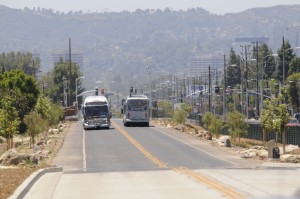Last year, the Los Angeles Times made a lot of waves when it ran a piece decrying falling transit ridership. They used what I called a misleading chart to make the decline look worse than it really was.
Now the paper is back with more disheartening news about Los Angeles transit ridership, from transportation reporter Laura Nelson:
Trips taken on the Metropolitan Transportation Authority’s sprawling bus and rail system dropped again in 2016, by nearly 6%, driven by a continuing slide in bus ridership, according to agency data.
Although year-to-year ridership changes are worth noting, the bigger issue is how Metro has fared over time, said Michael Manville, a professor of urban planning at UCLA’s Luskin School of Public Affairs.
Since 2009, Metro has opened four new rail extensions at a cost of more than $4 billion. In the same period, rail ridership soared 21%, but bus trips — a much larger share of overall ridership — dropped 18%.
Subway and light-rail boardings rose 4.4%, bolstered by the debut of the Gold Line and Expo Line extensions. But those gains did not cancel out a decline in annual bus ridership, which fell 8.9% to 304 million — the lowest in more than a decade.
While it was a bit easy to dismiss last year’s article, at this point I think we’ve reached the point of worry.
So what gives?
Surprisingly, no one seems to have any firm answers. The theories range from weak transit performance on on-time arrivals, poor overall service (convenience of the routes and time spent waiting), passenger fears about safety, a stronger economy that encourage more people to drive, drivers licenses for undocumented immigrants, and the rise of ride-hailing services like Uber and Lyft.
To be sure, this is a national trend on transit ridership, as is the trend of increasing vehicle miles traveled.
If I had to guess, I would venture that two trends loom largest: the growing economy and the rise of Uber and Lyft.
With nationwide vehicle miles traveled increasing, it seems likely that much of that driving is coming at the expense of transit ridership. With a robust economy, more people can afford to purchase cars and the gasoline to fuel them.
But the rise of ride-hailing services like Uber and Lyft should not be understated. Anecdotally, I hear about bus riders who can cost-effectively take Uber Pool or Lyft Line to their destinations, saving a huge amount of time in the process if they live far from their jobs and have to transfer multiple times (or catch the bus at non-commute hours when the waits are long).
For low-income people, particularly those on hourly wages, that time savings can quickly equate to badly needed increases in earnings from more hours worked.
But all is not lost for transit investments. As I wrote last year in an op-ed for the Times, transit agencies still have plenty of options. The big three:
- Encourage the building of more homes and offices within walking distance of transit stops
- Reduce fares
- Focus on building bus-only lanes on major boulevards and highways
Honestly, transit agencies should be doing these things anyway. Maybe the alarm bells about falling transit ridership will finally give them the political motivation they need to start implementing.
3 thoughts on “Falling Transit Ridership Is Becoming A Problem”
-
Pingback: Today’s Headlines – Streetsblog Los Angeles
-
Pingback: LA Metro Will Slowly Re-evaluate Its Entire Bus System In Light Of Declining Ridership | Ethan Elkind
-
Pingback: Finally, Data Show How Uber & Lyft Cannibalize Transit Use & Increase Driving Miles | Ethan Elkind
Comments are closed.



